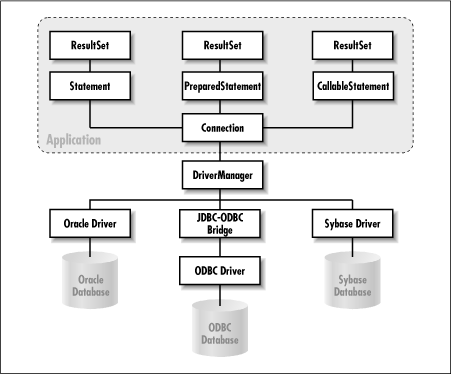 | Part 1: Introducing the Java Enterprise APIs |  |

JDBC Architecture
JDBC Basics
JDBC Drivers
Connecting to the Database
Statements
Results
Handling Errors
Prepared Statements
Metadata
Transactions
Stored Procedures
Escape Sequences
JDBC 2.0
The JDBC[1] API provides Java applications with mid-level access to most database systems, via the Structured Query Language (SQL). JDBC is a key enterprise API, as it's hard to imagine an enterprise application that doesn't use a database in some way. This chapter starts by demonstrating the central concepts and classes that comprise the original JDBC API (JDBC 1.0), which was introduced as an add-on to Java 1.0 and included as part of the core Java 1.1 API. It concludes with an introduction to the new JDBC 2.0 features that are provided as part of Version 1.2 of the Java 2 platform.
[1]According to Sun, JDBC is not an acronym for Java Database Connectivity, although most people assume it is.
A word of caution: while the java.sql package is less complicated than, say, the RMI packages, it does require grounding in general database concepts and the SQL language itself. This book does include a brief SQL reference (see Chapter 8, "SQL Reference", but if you have never worked with a relational database system before, this chapter is not the place to start. For a more complete treatment of JDBC and general database concepts, I recommend Database Programming with JDBC and Java by George Reese (O'Reilly).
Different database systems have surprisingly little in common: just a similar purpose and a mostly compatible query language. Beyond that, every database has its own API that you must learn to write programs that interact with the database. This has meant that writing code capable of interfacing with databases from more than one vendor has been a daunting challenge. Cross-database APIs exist, most notably Microsoft's ODBC API, but these tend to find themselves, at best, limited to a particular platform.
JDBC is Sun's attempt to create a platform-neutral interface between databases and Java. With JDBC, you can count on a standard set of database access features and (usually) a particular subset of SQL, SQL-92. The JDBC API defines a set of interfaces that encapsulate major database functionality, including running queries, processing results, and determining configuration information. A database vendor or third-party developer writes a JDBC driver, which is a set of classes that implements these interfaces for a particular database system. An application can use a number of drivers interchangeably. Figure 2-1 shows how an application uses JDBC to interact with one or more databases without knowing about the underlying driver implementations.


Copyright © 2001 O'Reilly & Associates. All rights reserved.